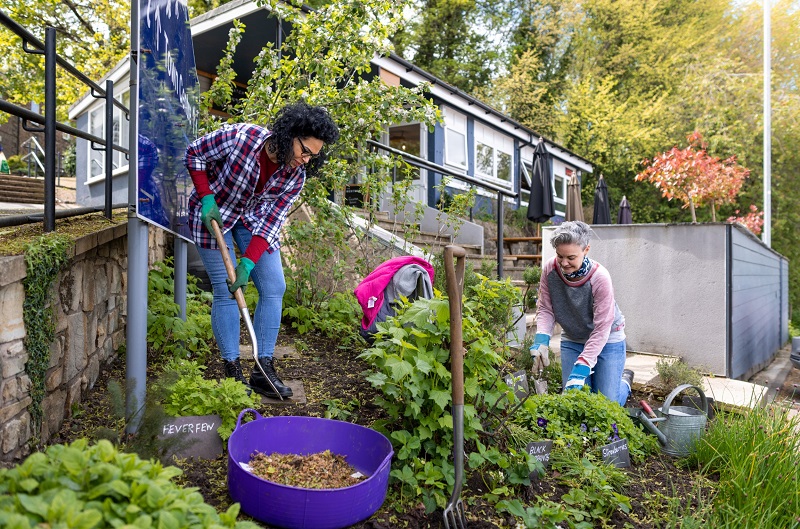Updated: November 7, 2023
In an age increasingly being defined by shared resources and collective consumption, the Sharing Economy has left few stones unturned. The sacred domain of homeownership, long considered an individual or nuclear family pursuit, has also been undergoing transformative shifts from the phenomena of “shared economics” and “shared buying power”.
Co-living and co-owning trends have emerged as innovative solutions in the housing sector, challenging traditional norms. This lifestyle preference has become so prevalent, in fact, that using the appropriate terminology in house listings is considered vital to ensuring your home has what millennial homebuyers want.
These communal models emphasize a collaborative approach, revealing a nuanced picture of modern-day living and property ownership.
Though this emerging form of homeownership can offer valuable opportunities and benefits for aspiring homebuyers, this arrangement is rife with risks. Here’s what to know if you are considering this type of homeownership and how to tell if it’s a good fit for you in terms of investment and overall lifestyle compatibility.
Table of Contents
- Co-Owning Statistics & Trends
- What is the Sharing Economy?
- What is Co-Living?
- How Co-Buying & Co-Owning Works
- Why is Co-Owning Homes Becoming Popular?
- The Challenges of Co-Buying
- Is Co-Owning a Home Right for You?
- How to Mitigate Co-Buying Risks
- Is Co-Ownership the New American Dream?
- Co-Buying & Co-Living Resources
Also see:
Co-Owning Statistics & Trends
Before we dive into the details and latest trends of co-homeownership, recent statistics from the Zillow 2023 Consumer Housing Trends Report (CHTR), will help paint an accurate picture of this sizable, emerging trend. This report surveyed homeowners in early-to-mid 2023 who had purchased a home within the prior 12 months.
- Most homebuyers (62%) purchase and share ownership of their home with at least one other person
- 1 in 5 homebuyers (21%) say they co-bought with a friend or relative, who was not their spouse or partner
- 46% of co-buyer respondents cited ease of getting approved for a mortgage as a key reason for co-buying a home
- 44% of co-buyer respondents cited affordability as a key reason for co-buying a home
- 19% of co-buyer respondents cited “I do not want to live alone” as a key reason for co-buying a home
- 32% of all mortage homebuyers surveyed were denied financing at least once before getting final approval
- 55% of Millennial homebuyers cited “being able to rent out a portion of their home while still living in it” as important
- 51% of Gen Z homebuyers cited “being able to rent out a portion of their home while still living in it” as important

Here are two additional somber stats provided by Sharetini likely fueling the growing interest in co-ownership:
- 89% of Millennials want to become homeowners
- 67% of aspiring Millennial homebuyers will have to wait 20 years or more to afford a home
What is the Sharing Economy?
It’s never been more imperative to save money and make the most out of what we have than it is today. With inflation making everything more expensive, many consumers are finding that their wages are not adequately compensating price increases.
Enter the Sharing Economy
The underlying principles of the Sharing Economy can help people affordably and conveniently access vital goods and services by sharing costs and resources with others. It’s a simple concept, but it can have a dramatic impact on one’s quality of life and day-to-day financial obligations. Though the concept of “sharing” business models is old (think short-term rentals of all kinds: cars, tools, furniture, tuxedos, etc.), innovative technology and entrepreneurs are making previously unimagined applications of “sharing” possible and scalable.

Partakers in the Sharing Economy are not just motivated by cost-savings, but convenience and practicality, as well. For example, residents of large congested cities have always understood the impracticality of owning a car, especially without having access to a private and secured parking space. Even with private parking, the need for a car is dramatically reduced for city dwellers given the close proximity of key amenities and ample means of convenient public and private transportation.
Examples of the Sharing Economy Here to Stay
Uber, Airbnb, and Lyft are three well-known companies that have entrenched principles of the Sharing Economy into the everyday lives of a huge portion of the population. Even if you don’t use any of them, you probably know how to refer to them in everyday conversation.
In short, these disruptive innovators enable people to share vehicles and short-term housing rentals affordably and conveniently. The concept of sharing also extends between “sharing economy workers” (e.g. drivers and property owners of short-term rentals) and their corporate partners (e.g. Airbnb, Uber and Lyft).
While independent “workers” get access to powerful technology to facilitate flexible earning potential, the “host companies” gain “shareable” access to valuable and costly capital assets (e.g. cars and vacation properties). This type of symbiotic partnership is a great way for businesses to save money on overhead costs and for individuals to earn supplemental income flexibly and conveniently.
The sharing economy is revolutionizing the way we approach homeownership, too.
As traditional homeownership has become unattainable for many prospective buyers in numerous costly real estate markets, accessory dwelling units (ADUs) and barndominiums have become smart investments. This trend is largely due to the growing adoption of the sharing economy and the advent of co-living.
Whether you want to earn extra money, or rent or buy a home, the sharing economy can help you maximize your resources cost-effectively and seamlessly.
What is Co-Living?
Co-living is when multiple people share a living space, typically with shared common areas and is often resorted to as an alternative to traditional homeownership. Co-living emerged as one of the more creative ways to monetize your home, (AKA house hacking) but it’s become a growing trend in the sharing economy, whereby people can rent or own a property with other people.

Co-living can be an attractive option for those who want to save money, enjoy a shared living space, and benefit from a sense of community. It can provide a great alternative to traditional homeownership, allowing people to enjoy the benefits of living together without the financial burden of a single-family residence.
According to CoLiving.com, the following factors have been and will continue to grow the co-living lifestyle:
- Dire shortage of affordable housing
- The growth of urban populations
- The “loneliness pandemic”
- Increased demand for more flexible ways of living
- The rise of hybrid-working and “digital nomads”
Multigenerational households are unique example of intrafamily co-living that has been a common practice throughout the world, with it finally gaining traction in recent years in the United States.
Co-living also allows people to live in a larger space with more amenities than they could afford on their own. Depending on your budget and preferences, you can either rent or purchase a co-living space.

Co-living spaces can come in the form of any residential structure, from large homes with multiple bedrooms and bathrooms to small apartments. In some cases, the owner of the co-living space may provide amenities such as high-speed Internet, furniture, dinnerware and cleaning services. Residents can also enjoy common areas such as a shared living room, dining room, and outdoor spaces.
Co-living and co-owning have become increasingly popular in the United States, especially among millennials and young professionals. The latest trend in co-living is the emergence of luxury co-living spaces that offer high-end amenities such as fitness centers, rooftop lounges, and communal kitchens.

Another trend is the rise of “pocket neighborhoods,” small communities made up of tiny homes or small apartments clustered around a shared space like a garden or courtyard. These trends reflect a growing desire for affordable and community-focused housing options in the U.S.
Co-living has similarities with roommate households, but it goes a long way in eliminating the negative connotations of the temporary nature of the roommate lifestyle. A key difference between co-living and having roommates is that persons actively seeking a co-living arrangement are seeking opportunities for positive social engagement.
Key to this pursuit is shared spaces and amenities, as well as understanding the importance of mutual respect, aligned lifestyle priorities and overall compatibility. Coliving companies, such as Europe-based LifeX, position themselves as offering comfort, convenience, and community.
How Co-Buying & Co-Owning Works
Co-buying, as the name suggests, involves a group of people pooling their resources to purchase a property together. It offers a way to share the financial burden of homeownership, making it more affordable for individuals.
Co-buying typically involves creating a legal agreement, specifying ownership shares, responsibilities, and decision-making processes. This agreement is essential to ensure clarity and avoid disputes in the future. Co-buyers fund the down payment, and as co-owners they contribute to mortgage payments, property taxes, and maintenance costs, sharing housing expenses, and reducing individual financial strain.
Co-buying arrangements can be structured in different ways. Some co-owners may choose to live together, sharing living space, common areas, and appliances, similar to townhouse living. Others may opt for separate living spaces within the property, such as condo-style living, while still pooling resources for property-related expenses. Co-buyers need to establish upfront clear communication channels and ways of resolving disagreements, ensuring a harmonious living arrangement.
If you’re thinking about co-owning a home, there are typically two main ways to go about co-ownership:
- Tenancy in Common (TIC)
- Joint Tenancy with Right of Survivorship (JTWROS)
TIC allows flexibility in ownership, and shares can be divided based on investment amounts. JTWROS, on the other hand, divides ownership equally and includes automatic assumption of shares in the event of death.
Co-buying can be facilitated through specialized companies or real estate professionals, who have expertise in co-buying arrangements, property valuation, and legal considerations. Seeking professional guidance can make the process of co-buying smoother and more efficient.
Why is Co-Owning Homes Becoming Popular?
With house prices outpacing the buying power of many prospective buyers, more folks are teaming up to buy homes together. It can absolutely be a smart move!
The majority of benefits of co-owning can be lumped into two categories
Financial Empowerment
Financial advantages of co-owning a property can be actualized at the onset (e.g. qualifying for a loan and making a down payment), as well as throughout the entirety of jointly owning a property (e.g. reduced shared-costs, such as utilities; equity appreciation; tax deductions).
By sharing the initial down payment and the monthly mortgage, owning a home can be a viable option for many who felt homeownership was not feasible. In particular, co-owning a home can help individuals with either low credit scores or insufficient cash reserves for a down payment. Though the buyer with the lowest credit score determines the interest rate (not the average credit score), lenders will combine the income and debts of all co-buyers to determine how much home can be purchased.
Sharing housing costs, such as mortgage payments, property taxes, and maintenance expenses, reduces individual financial strain. Co-owning can offer long-term financial stability, as property values tend to appreciate over time, providing potential returns on investment.
Additionally, co-buying may provide tax benefits, such as deductions for mortgage interest and property taxes. By sharing property ownership, co-owners can leverage these tax benefits, further reducing their overall housing expenses. Furthermore, co-buying can be a way of diversifying real estate investments, spreading risk among multiple owners.
Co-owning a home can also provide legal protection during a split. When co-owners decide to part ways, the asset is divided in a predetermined way, making dividing assets easier.
Social and Emotional Benefits
Beyond financial advantages, co-owning also provides social and emotional benefits to its participants.

Most importantly co-ownership can provide long-term stability, where co-owners are no longer at risk of annual rent increases, leases being unexpectedly terminated, or dealing with poor upkeep by a negligent landlord.
Co-buying can offer an opportunity to build stronger relationships with fellow co-buyers, as co-owning households often emphasize communal living, fostering a sense of community among residents. This approach can offer an alternative way of living, such as designing and featuring shared spaces and amenities to facilitate interaction and collaboration among co-owners.

Sharing responsibilities can reduce stress and increase overall well-being, as well.
The Challenges of Co-Buying
While co-buying offers many benefits, it is not without its challenges. It is important to consider and address these challenges before entering into a co-buying arrangement.
Legal Issues and Disputes
One of the major challenges of co-owning is the potential for legal issues and disputes. Disputes can arise over maintenance, repairs, and financial contributions, among other issues. It is essential to address these potential disagreements in the co-buying agreement, establishing clear mechanisms for resolving conflicts. Co-buyers should also consider obtaining separate legal and financial advice to protect their individual interests.
In case of a dispute, mediation or arbitration may provide cost-effective and efficient alternatives to litigation, allowing co-owners to resolve disagreements in a mutually satisfactory manner.
Risks of Co-Buying
Co-buying, like any investment, involves certain risks that need to be considered. Firstly, there is the risk of potential loss of investment if property values decline. While property values tend to appreciate over time, economic factors can lead to periods of depreciation, which may impact the value of the property owned.
Secondly, co-buying can lead to disagreements and conflicts during the ownership phase, which may impact living arrangements, property management, and decision-making processes. It is important to establish clear communication channels, decision-making protocols, and conflict resolution mechanisms to mitigate these risks.
There is also the risk of one or more co-owners defaulting on their financial responsibilities, putting additional strain on the remaining co-owners. To mitigate this risk, it is crucial to conduct due diligence on each co-buyer’s financial stability and ability to contribute to property-related expenses.
Lastly, co-owning may limit individual autonomy, as decisions regarding property usage, maintenance, and renovations require group consensus. This can lead to delays or disagreements in property-related projects. It is important to have open and transparent communication among co-owners, ensuring that decisions are made in the best interest of the group.
Is Co-Owning a Home Right for You?
Entering an ownership partnership of any kind with another person presents unique risks and challenges, even when related. Therefore it’s crucial to determine upfront if co-owning is a good fit for you by considering several interrelated questions:
- Do you understand the risks of connecting your financial well-being with your co-owner(s)?
- Does a co-living lifestyle appeal to you?
- Is the prospective property conducive to a co-living lifestyle?
- Is your lifestyle conducive to a co-living lifestyle? (E.g. work hours; need for privacy; presence of children; pet ownership; etc.)
- Are you compatible with your co-owner(s)?
- Are all aspects of co-ownership and co-living well-defined in writing with coverage for any unexpected or unusual events or circumstances? (E.g. death; relocation; marriage; unemployment; buyout offers; disagreements; maintenance costs; renovations; lawn care; exit terms (AKA exit strategy, separation terms); etc.)
- Have you consider other “house hacking” options? (E.g. renting one half of a duplex; renting out an ADU; buying a multigenerational home or compound; getting a co-signer/co-investor; rent-to-own programs; etc.)
Co-buying can definitely help you score that dream home within your budget, but there’s a lot to consider before taking this path to homeownership. Before taking the plunge, do some real soul-searching. If your emotions are taking charge and you’re disregarding logic in the pursuit of an elusive ideal home, it could spell disaster.
Dealing with any co-living arrangement can become complicated, but experiencing setbacks when co-ownership is involved is rife with peril, as you may not be able to exit this situation quickly or easily.
When your biggest asset is tied up with someone else, any rough patches in the relationship can not only cause heartache, but they can be the source of financial and legal hardship, as well. Be sure to have all your personal and legal liability bases covered upfront.
If one co-owner can’t make their share of payments, the burden will fall to the other co-buyer(s). In the event of a split, how the asset will be divided must be predetermined in writing.
Therefore, you will want to have a written agreement prepared by a real estate attorney to address how to handle someone leaving the arrangement and how shares will be passed on in the event of death. Also make sure to factor in the potential risks, which can include the legal implications of the arrangement or your co-owner regularly coming up short on their share of the payments. Ultimately, co-buying a home is a personal decision that should be carefully considered before committing.
How to Mitigate Co-Buying Risks
While co-buying has its inherent risks, there are ways to mitigate them, ensuring a smoother and more successful co-buying and co-owning experience.
Three key topics that are important to research and understand before entering a co-ownership partnership are:
- Legal Agreements for Co-Buying & Co-Owning
- The Role of Professional Guidance
- Planning for Worst-Case Scenarios
Legal Agreements for Co-Buying & Co-Owning
The most effective way to mitigate risks in co-owning a property is to have a well-written legally binding agreement in place. This agreement should clearly outline each co-buyer’s responsibilities, ownership percentage, property usage, maintenance obligations, and dispute resolution methods. Proper legal documentation can safeguard against ownership-ending disagreements and can ensure a smooth co-buying and co-ownership experience.

By having a comprehensive ownership agreement, co-owners can avoid potential conflicts by knowing how to address any issues that may arise in the future. It is essential to consult with a lawyer experienced in co-ownership-related real estate law before finalizing the agreement, ensuring that all legal aspects are properly covered for your unique situation.
A well-defined legal agreement can also surface any irreconcilable disagreements early in the process, thus preventing any costly and inconvenient setbacks that could occur after a property has been purchased.
The Role of Professional Guidance
Seeking guidance from real estate professionals experienced in co-buying arrangements can also significantly mitigate risks and ensure a successful co-buying experience.
These professionals can provide valuable insights on property valuation, financing options, and legal considerations, guiding co-buyers throughout the process.
Real estate professionals can also offer advice on property selection, location, amenities, and long-term investment potential, helping co-buyers make informed decisions. With their expertise, co-buyers can navigate the co-buying process with confidence and peace of mind, reducing the risks involved.
Additionally, an experienced real estate agent can walk you through other paths to homeownership, not just co-buying, to help you determine which scenario will work best for your unique needs and circumstances.
Planning for Worst-Case Scenarios
When soliciting advice (e.g. financing, legal, purchasing) from real estate professionals pertaining to co-buying and co-owning, be sure to ask questions around worst-case scenarios. Any well-written agreement should be able to handle eventual exit scenarios (e.g. selling the property or ending the partnership), as well as unexpected events (e.g. death). All involved parties should understand and have access to the underlying terms, procedures, legal responsibilities and options for resolution.
Examples of “worst-case scenarios” for co-owning partnerships include:
- Unemployment: A co-owner becomes unexpectedly unemployed and unable to pay their portion of the mortgage
- Irreconcilable differences: What if co-owners stop communicating and wish to break up the partnership?
- Needing to sell at a loss: Are short sales an option for co-owners and how are they handled?
- A co-owner desperately wants out of the partnership sooner than expected
- Costly damages are incurred due to an accident that is not covered by insurance
Is Co-Ownership the New American Dream?
The very essence of homeownership is undergoing a profound metamorphosis, propelled by the sharing economy’s principles. Co-living and co-owning, while still nascent, embody the future aspirations of many seeking to navigate the complex and financially challenging terrain of property ownership.

In a world moving towards collaborative consumption, these trends illustrate that the essence of home is not merely about individual ownership but about shared experiences, collective responsibility, and interconnected lives.
As more real estate service professionals and home builders cater to this growing segment of aspiring homebuyers, we are confident that co-homeownership will be a prosperous path to homeownership for millions of Americans.
Co-Buying & Co-Living Resources
Here is a collection of resources to help you learn more about co-living, co-buying and co-owning a residential property.
Co-Buying & Co-Ownership Resources
- Sharetini: Co-Ownership Marketplace
- WeCoOwn
- Key: Co-Ownership Marketplace for Homebuyers & Property Owners (Toronto)
- Nolo: Legal and Financial Issues to Consider When Co-Owning a Home
- Southern California Co-Ownership Homes
Co-Living Rental Resources
- Bungalow
- Cohaus (Los Angeles)
- Coliving.com
- Colivys (France)
- The Collective (London)
- Common
- Diggz
- Gravity Co-Living (London)
- La Casa (Paris)
- LifeX (Europe)
- Node
- Roomrs
Vacation Home Co-Ownership Resources
More Recommended Home Buying Articles
- 8 Common Mistakes Made When Budgeting for a New Home
- 7 Questions to Ask Your Banker When Applying for a Home Loan
- Want the Best Mortgage Deal? Study APRs vs. Interest Rates!
- Proptech That Enables Homebuyers to Make All Cash Offers
- Green Mortgages: An Eco-Friendly Way to Combat Rising Interest Rates
- Want a Nontraditional House? Here’s How to Finance It!
- Options for Millennials Determined to Own a Home
- Enjoy Working Remotely? Here’s How to Choose to Live Wherever You Want
- Never Thought You’d Own Land? Think Again!
- Related Topics: Mortgages | Home Buying | Real Estate | Proptech
Legal Disclaimer: The information provided in this article and on this website does not, and is not intended to, constitute legal advice; instead, all information, content, and materials available in this article and on this site are for general informational purposes only.
| Purgula is reader-supported. When you click on links to other sites from our website, we may earn affiliate commissions, at no cost to you. If you find our content to be helpful, this is an easy way for you to support our mission. Thanks! Learn more. |








Great article. Homeownership is getting harder and harder these days. Nice to know someone is trying to get some answers